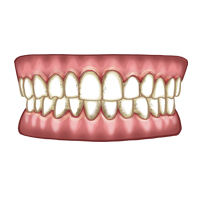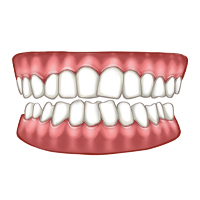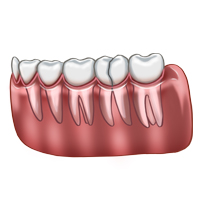
The average adult has between 28 and 32 permanent teeth. The wisdom teeth, located at the back of the jaw behind the second set of molars, are the last teeth to emerge. Some Houston residents never develop these teeth, while others develop one to four of their third molars. Approximately 25% of adults are missing at least one wisdom tooth. If there is not enough room in the jaw to accommodate the wisdom teeth, or they are not positioned correctly, they may cause discomfort, infection, or damage to existing teeth.
Because wisdom teeth develop differently for each person, an initial evaluation is typically conducted during the teenage years by a dentist, orthodontist, or oral and maxillofacial surgeon. The position of the teeth is monitored through an oral examination and radiographs of the mouth to identify existing or potential problems. Wisdom teeth generally erupt between the ages of 17 and 25, but they can be seen in x-rays beginning around age 12.
Ideally, wisdom teeth should be removed early on while the bone is more forgiving, teeth are not fully formed, and the root structure is not fully developed. This may occur anywhere from the early teens to the early twenties. After age 30, there is a greater risk for complications due to the fully formed root structure and proximity of the root to the sensory nerve in the lower jaw and the sinuses in the upper jaw.
Common Reasons for Wisdom Teeth Removal
As humans have evolved and diets have changed, the need for wisdom teeth has diminished. If this third set of molars come in properly and meet the right conditions, they may not cause any problems and can remain intact. If there is not enough room for wisdom teeth to fully erupt, they may become impacted and will need to be removed in order to prevent potential problems. Impacted teeth may not break through the gum at all or may only partially erupt. Failure to remove impacted wisdom teeth can lead to issues including:

Gum infection: Also known as pericoronitis, gum infections can develop in the tissue around the impacted tooth. This can lead to red, swollen gums along with discomfort and difficulty chewing or swallowing.

Cysts or tumors: Fluid-filled sacs called cysts may form in the jaw bone near the wisdom teeth. If left untreated, they can cause bone deterioration and damage to teeth as they grow. In some cases, a benign tumor may form in the bone.

Crowding: When wisdom teeth try to erupt, but the jaw is too small to accommodate them, crowding can occur. Existing teeth, especially lower front teeth, may be shifted out of alignment. Crowding can cause chewing problems, make thorough cleaning difficult, and also lead to damage of surrounding teeth, gums, and bone.

Tooth Damage: The location of the wisdom teeth in the back of the mouth, as well as potential impaction, can make these molars difficult to clean and maintain. Periodontal disease, decay, and bone loss can develop around the wisdom tooth and adjacent teeth.
Early evaluation and monitoring can detect potential problems before they occur. Even if you are not experiencing any problems, wisdom teeth should be checked every year to determine if a tooth extraction is necessary to maintain good oral health.
Preparing for Surgery
Radiographs of the mouth will be used to determine the exact position of the wisdom teeth. The doctor can clearly visualize the tooth, root structure, and bone in order to plan the extraction and explain how the process will be performed.
We offer several options for anesthesia to minimize discomfort, and our doctors are fully licensed and trained to safely provide anesthesia in-office for maximum relief.
- Local Anesthetic: For a simple extraction, a local anesthetic may be injected to numb the nerves. This will prevent you from feeling any discomfort, but you will still feel pressure as the tooth is removed and be fully alert.
- Nitrous Oxide Plus Local Anesthetic: In addition to a local anesthetic, nitrous oxide may also be administered. Nitrous oxide, also called laughing gas, is a mild sedative that helps to reduce anxiety, dull discomfort, and create a feeling of euphoria. You will be awake, but not fully alert.
- General Anesthesia: General anesthesia may be administered intravenously for full sedation to prevent you from feeling any discomfort or pressure during the procedure.
Your doctor will help you decide which level of anesthesia is appropriate based on your overall health and preferences. If you are receiving anesthesia, you should refrain from eating or drinking for at least six hours prior to surgery to minimize potential nausea and vomiting. Wear comfortable clothing, including short sleeves, for easier IV administration. Arrange to have a responsible adult drive you home afterward, as you will not be permitted to drive yourself. The effects of general anesthesia can take several hours to fully resolve, and you will feel tired and disoriented.
Smoking is also discouraged for at least 24 hours before and after surgery. Nicotine can affect circulation and slow healing.
The Surgical Process
Wisdom tooth removal is an outpatient procedure that can be performed in the oral and maxillofacial surgeon’s office. The length of surgery depends on several factors, including:
- Position of the tooth
- Length and curvature of the roots
- Bone thickness around the tooth
A non-complicated surgery where the root structure has not fully formed can often be performed in 45 to 60 minutes for removal of all four wisdom teeth. More complicated procedures where the root is tangled with the sensory nerve can take longer.
After anesthesia has been administered, the doctor will begin extracting your wisdom teeth. If the tooth has fully erupted, it may be removed in one piece. A tool called an elevator is used to widen the socket, and the loosened tooth is extracted using forceps. If the tooth is impacted, a small incision will be made in the gums to fully expose the tooth. Any bone that is blocking the tooth will be removed to prevent damaging adjacent teeth. At this point, the tooth may be sectioned and removed into smaller pieces.
Once the entire tooth and root are extracted, dissolvable stitches may be used to close the extraction site. The stitches will dissolve on their own as the gums heal. A piece of clean gauze will be placed over the site, and you may be asked to bite down in order to apply pressure and stop any bleeding.
Following surgery, your breathing and consciousness will be monitored as the anesthesia wears off. Once you are awake and alert, you will be provided with a list of post-operative instructions and discharged.
Recovery Following Wisdom Tooth Extraction
The anesthesia will prevent you from feeling any discomfort during the surgery and for a few hours afterward. Over-the-counter discomfort relievers or prescription medications can be used to manage discomfort and swelling at home. You can also apply an ice pack wrapped in a towel to your cheek in 20-minute intervals. If you experience any bleeding, bite down on a gauze pad or a damp tea bag for several minutes. Tea contains tannic acid, which helps contract blood vessels and stops bleeding.
Additional Recovery Tips:
- Begin taking any antibiotics the doctor prescribed to prevent infection.
- It is normal to feel tired and groggy after receiving anesthesia.
- Keep your head elevated while resting to minimize discomfort and bleeding at the extraction site. Start with a diet of clear liquids such as water, juice, broth, or Jell-O.
- Avoid any dairy products as they may interact with the anesthesia medication and cause nausea or vomiting.
After the First Day
Your gums will be swollen for a few days after surgery and may feel as though they are pulling away from your teeth. This sensation is normal and will pass as the swelling decreases. If you are tolerating clear liquids, you can begin adding very soft foods to your diet, such as creamy soups, pudding, applesauce, scrambled eggs, steamed vegetables, or well-done pasta. Avoid foods that are hard, crumbly, spicy, or sticky until the site has fully healed.
Listen to your body, and if you experience any discomfort, switch to softer foods. Drink plenty of fluids to stay hydrated and keep your mouth moist, but avoid drinking from a straw for at least one week as the force of the suction can interfere with blood clot formation in the socket.
After 24 hours, you may begin rinsing your mouth with a warm salt-water solution. Mix half a teaspoon of salt with eight ounces of warm water and gently swish it around your mouth. The salt raises the pH level in your mouth and helps to kill bacteria. It also flushes away any plaque or food particles from the extraction site. Avoid forcefully spitting the water out as this can prematurely dislodge the blood clot that has formed in the socket.
Normal activity can be resumed within a day or two, and many patients return to work or school within a week. Any strenuous activity, such as vigorous exercise or heavy lifting, should be avoided for at least one week to prevent additional bleeding. Over the next few weeks, the socket will naturally and predictably fill in with new bone. There are no long-term restrictions following wisdom teeth removal.
Are There Risks Associated with Wisdom Teeth Removal Surgery?
Any surgery involves some level of risk, but wisdom teeth removal is considered very safe when performed by a board-certified oral and maxillofacial surgeon. Potential complications to be aware of include:
- Dry Socket: This condition, also known as alveolar osteitis, occurs when the blood clot is dislodged, exposing the nerve and bone. You may experience intense discomfort in your jaw and up toward your ear, as well as a foul taste in your mouth. Dry socket is treatable, but you should contact your doctor immediately.
- Infection: Dry socket can increase the risk of infection because bacteria and food particles can become trapped in the empty socket. Discomfort and swelling that develop in the days following surgery may be a sign of infection. Your doctor will give you antibiotics to help reduce risk.
- Nerve Damage: The lower jaw contains a sensory nerve that gives sensation to the lips, tongue, and chin. If the tooth root becomes tangled with the nerve, or the nerve is damaged during tooth extraction, it can cause tingling or numbness to these areas. This is often temporary and resolves on its own, but permanent damage can occur.
How Much Does Wisdom Teeth Removal Cost?
Surgical costs can vary depending on each patient’s individual situation. Factors that may affect pricing include:
- Geographic location
- Surgical facility (in-office or outpatient surgical suite)
- Pre-surgical imaging or tests
- Complexity of surgery
- Type of anesthesia administered
- Post-operative medications
- Dental insurance coverage
During your consultation with your oral and maxillofacial surgeon, a more accurate quote can be provided. Many offices offer financing or payment plans to improve affordability and access to appropriate oral health care.
Improving Dental Health Through Wisdom Teeth Removal
Whether you have a teenager whose wisdom teeth are just beginning to erupt, or you are an adult whose wisdom teeth are causing problems, removal can be an effective option for alleviating discomfort and enhancing oral health. Consulting with an oral and maxillofacial surgeon can help you understand how these teeth are developing, or why you are experiencing discomfort. In addition, the doctor can discuss the benefits of wisdom tooth removal, explain the surgical process, and answer any questions or concerns you may have.
Lighthouse Oral and Maxillofacial Surgery strives to create as painless of a wisdom tooth removal process as possible to maximize your comfort and allow you to get back to your daily life.
Schedule a consultation today to learn more about how you could benefit from wisdom teeth removal, along with the steps our doctors take to make it a relaxing and positive experience for all. Call us at (713) 790-1995.